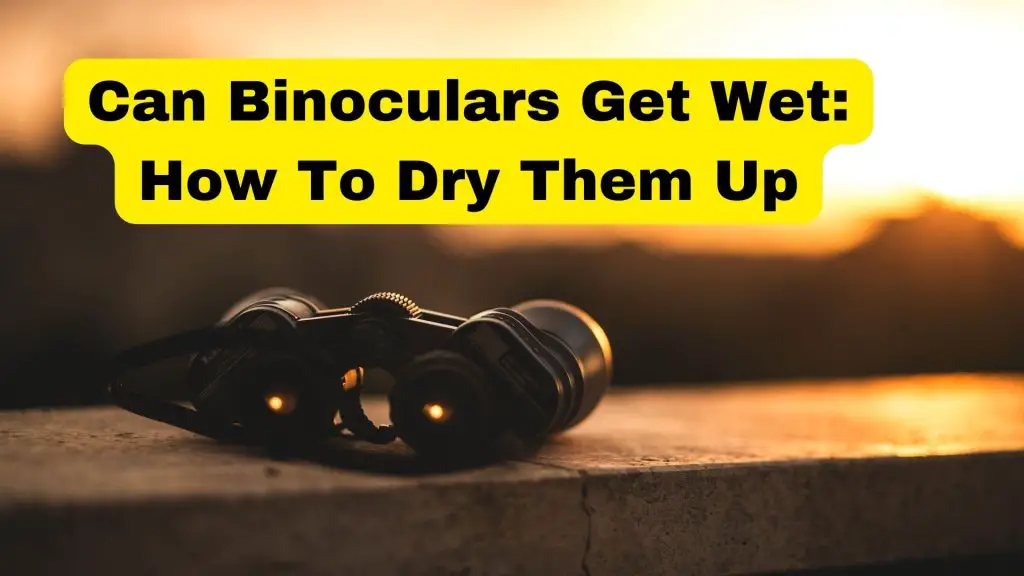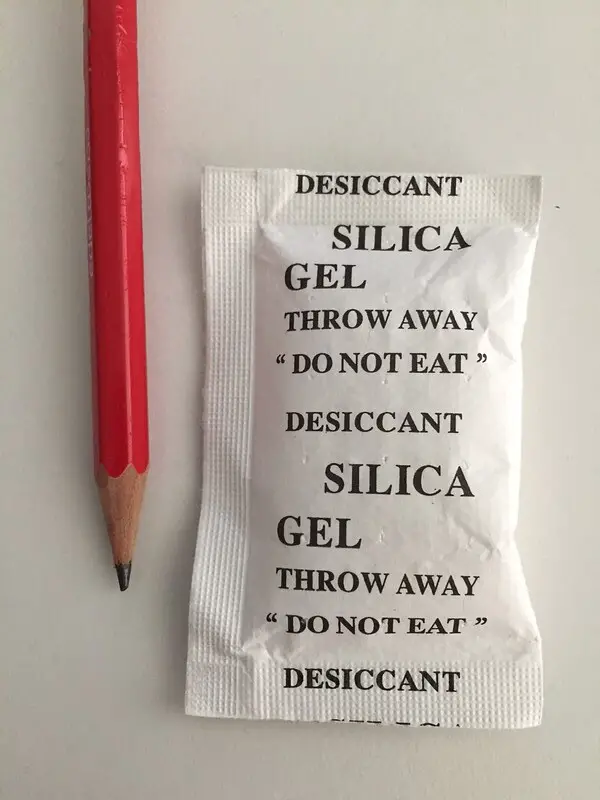Can Binoculars Get Wet: How To Dry Them Up
Have you ever found yourself caught in a rainstorm while using your binoculars, or accidentally dropped them in water during a hike?
If so, you may have wondered if your binoculars can get wet and how to dry them up.

The answer is yes, binoculars can get wet, and moisture can cause damage to the lenses and internal components.
But don’t worry, in this article, we’ll explore the causes and effects of wet binoculars and provide you with tips on how to dry them up.
So, if you’re an avid outdoor enthusiast or just want to learn how to properly care for your binoculars, keep reading!
Can binoculars get wet?
Binoculars are an important tool for outdoor activities such as bird watching, hunting, and camping. However, they are vulnerable to moisture, which can damage their delicate internal components and affect their performance.
Causes of getting wet
Binoculars can get wet due to a variety of reasons. Rain, splashes of water, and accidental submersion in water are the most common causes.
Dew, humidity, and condensation can also cause moisture to build up on the surface of the binoculars, leading to internal damage.
In addition, exposure to saltwater can be particularly damaging to binoculars as it can cause corrosion.
Effects of getting wet
When binoculars get wet, the internal components such as the lenses, prisms, and electronic circuits can be damaged.
Moisture can cause the lens coatings to peel off, leading to blurry or distorted images.
Water can also damage the prisms, which are responsible for aligning and magnifying the image. Wet prisms can lead to decreased image quality, reduced brightness, and even complete failure.
Moreover, electronic binoculars can be severely damaged when exposed to moisture, potentially causing them to stop working altogether.
Another effect of getting wet is the growth of mold and fungus. When moisture is left inside the binoculars, it creates a damp environment that is ideal for the growth of mold and fungus.
This can lead to permanent damage to the optics and cause health issues for the user.
It is essential to address wet binoculars as soon as possible to prevent further damage. In the next section, we will discuss how to dry wet binoculars.
How to Dry Wet Binoculars
If your binoculars have gotten wet, it’s crucial to dry them out as soon as possible to prevent any further damage to their delicate components.
Here are some steps to follow to effectively dry your wet binoculars:
Steps to follow

- Remove the batteries (if applicable): If your binoculars have batteries, remove them immediately to prevent any potential electrical damage.
- Wipe the exterior: Use a dry microfiber cloth to wipe the exterior of the binoculars to remove any excess water. Be gentle and avoid rubbing too hard as it can damage the lens coatings.
- Remove the eyecups: Remove the eyecups and any other removable accessories such as rubber coatings and straps to expose the internal components.
- Shake out excess water: Hold the binoculars upside down and gently shake them to remove any excess water that may be trapped inside.
- Use a desiccant: Place the binoculars in a bag , preferably a zip-lock bag filled with a desiccant such as silica gel bags or uncooked rice. The desiccant will absorb the moisture from the binoculars. Seal the bag and let it sit for at least 24 hours.The desiccant should absorb all the moisture from your binoculars, leaving them completely dry and ready to use again.
- Check for moisture: After 24 hours, remove the binoculars from the bag and check for any remaining moisture. If there is still moisture, repeat the process.
Note: If the binoculars got completely submerged or got extreme wet in the rains then firstly it’s best to move them to a warm and dry indoor area. Place them on a dry surface and allow them to dry out completely for a few days. It’s important not to rush the process and try to use them before they are completely dry. In most cases, moisture inside them should evaporate when exposed to warm airflow.
Drying tools to use
- Hairdryer: Use a hairdryer on the cool setting to blow air over the binoculars. Keep the hairdryer at least six inches away from the binoculars to avoid overheating the lenses.
- Dehumidifier: Place the binoculars in a room with a dehumidifier to remove moisture from the air. This is particularly useful in humid climates.
- Air compressor: Use an air compressor to blow air over the binoculars. Use a low-pressure setting and keep the air compressor at least six inches away from the binoculars.
Why Do My Binoculars Fog Up?
Binoculars may fog up due to a change in temperature or humidity.
When warm, moist air comes into contact with a cooler surface, like the lenses of binoculars, it causes condensation, which appears as fog on the surface. This is similar to what happens when you take a cold drink out of the fridge and it becomes “sweaty” on the outside.
Fogging can occur both externally and internally on binoculars. External fogging can be wiped away with a cloth, but internal fogging is more difficult to address and may require some time to dry out.
Internal fogging can be a particular problem in humid environments, especially if the binoculars have been stored in a cool area and are then taken into a warm and humid environment.
Additionally, changes in altitude, such as ascending or descending a mountain, can cause changes in temperature and humidity that may lead to fogging.
Most modern binoculars are fogproof and waterproof but extreme changes can even affect them.
Here is our Detailed Guide On How To Prevent Fogging and Condensation
Preventing Binoculars from Getting Moisture
While drying wet binoculars is essential to prevent damage, it’s always better to prevent them from getting wet in the first place.
Here are some tips to help you protect your binoculars from moisture:
Protective covers
Using protective covers for your binoculars is an effective way to prevent them from getting wet. Many manufacturers sell covers that are specially designed for their binoculars. These covers are usually made from water-resistant or waterproof materials that offer an extra layer of protection. Some covers even come with a strap, making it easy to carry your binoculars around.
Proper storage techniques
Proper storage is essential to prevent moisture from damaging your binoculars. When you’re not using your binoculars, store them in a dry, cool place. Avoid storing them in direct sunlight or places with high humidity. If you’re storing them for an extended period, place them in a dry container or bag with a desiccant.
Avoiding exposure to moisture
Avoid exposing your binoculars to moisture whenever possible. If you’re out in the rain, keep your binoculars in a protective cover or under an umbrella. If you’re near water, use a neck strap to keep your binoculars around your neck, so they don’t accidentally fall into the water.
Additionally, when using your binoculars in humid environments, wipe them down regularly with a microfiber cloth to remove any moisture. This will prevent moisture from accumulating on the lenses and other components
Use Antifogging Sprays Or Creams
Some binoculars come with built-in anti-fogging coatings, which help to prevent moisture from condensing on the lenses. If your binoculars don’t have this feature, you can purchase anti-fogging sprays or wipes.
To use an anti-fogging spray or wipe, first, clean your binocular lenses with a microfiber cloth. Then, apply a small amount of the anti-fogging solution on the lenses and use a clean cloth to spread it evenly. Make sure to cover the entire surface of the lenses, including the edges. Let the solution dry for a few minutes, and then wipe away any excess residue. Once the lenses are dry, they should be clear and fog-free.
It’s worth noting that some anti-fogging solutions may leave a slight residue on the lenses, which can affect the clarity of the image. To avoid this, it’s essential to use a high-quality solution that is specifically designed for use on optical lenses. Additionally, make sure to follow the manufacturer’s instructions carefully and avoid over-applying the solution.
Choose Binoculars With Water repellant Coatings
Binoculars with water-repellent coatings on lenses can improve visibility, make maintenance and cleaning easier, protect against water damage, extend the lifespan of the binoculars, and enhance durability.
However, water-repellent coatings can be more expensive than those without this feature, due to the added cost of the specialized coatings and the extra processing required to apply them to the lenses. This can make them less accessible for some people, particularly those who are on a tight budget.
Additionally, not everyone may require or prioritize water-repellent coatings on their binoculars, especially if they primarily use their binoculars in dry environments. In such cases, it may not be worth paying the extra cost for a feature they may not use or benefit from.
Additional Tips for maintaining binoculars
Here are some additional tips to help you maintain your binoculars:
- Clean your binoculars regularly with a microfiber cloth to remove dust and debris.
- Use a lens cleaning solution and a lens cleaning pen to clean the lenses.
- Avoid touching the lenses with your fingers as this can leave oil smudges.
- Keep your binoculars away from extreme temperatures and direct sunlight.
- Check the focus and alignment regularly to ensure your binoculars are working correctly.

Using Binoculars Around A Water Body
Using binoculars around a water body such as a sea or a lake can be challenging, as dropping them in the water could damage them.
Here are some tips.
Choose Floatable Binoculars:
Floatable binoculars are designed with features that help them stay afloat if they are accidentally dropped in water.
These binoculars typically have an air-filled chamber in the body that provides buoyancy and helps them stay on the surface of the water.
Some floatable binoculars may also have waterproof or water-resistant coatings to protect against water damage.
Here are a few examples of floatable binoculars:
- Steiner Navigator Pro 7×50: These binoculars are designed specifically for marine use and are built to withstand tough conditions on the water. They feature a floating prism system that keeps them afloat and visible if dropped in water. They also have a rugged, waterproof construction and high-contrast optics for clear views.
- Nikon OceanPro 7×50: These binoculars are another great option for marine use. They have a durable, waterproof and fog-proof design, as well as a built-in compass for navigation. The binoculars also feature a floating strap to help keep them afloat if dropped in water.
- Fujinon Polaris 7×50 FMTRC-SX: These high-end binoculars are designed for marine and outdoor use and feature a floating prism system to keep them afloat. They also have a waterproof and fog-proof design, as well as advanced optics for clear and bright views.
Also Check: Best Marine Binoculars
Use floatable straps:
Floatable straps are specially designed to help keep your binoculars afloat in water, even if they do not have built-in floatation capabilities.
These straps are typically made from buoyant materials such as foam, neoprene, or plastic, and attach securely to your binoculars using clips, buckles, or loops.
The buoyant material in the strap helps keep your binoculars on the surface of the water if they are dropped, making them easier to retrieve and reducing the risk of damage.
Floatable straps are easy to locate due to their vivid colours and can also provide extra security and peace of mind when using your binoculars around water, as you can be confident that they will not sink if dropped.
When choosing floatable straps, look for ones that are compatible with your binoculars and are designed to provide a secure and comfortable fit.
Some straps may be adjustable, allowing you to customize the length and fit to your preferences.
Additionally, consider the durability and quality of the materials used, as well as any additional features such as quick-release buckles or reflective detailing for increased visibility in low-light conditions.
Conclusion
In conclusion, it’s important to know that binoculars can get wet and that moisture can cause damage to the lenses and internal components.
However, there are steps you can take to prevent this from happening, and if it does, you can still dry them up and restore their functionality.
Also Check: Why My Rubber On Binoculars Are Sticky?
By following proper storage techniques, using protective covers, and avoiding exposure to moisture, you can keep your binoculars in excellent condition for years to come.
Remember to always maintain your binoculars and clean them regularly to ensure clear and sharp images.
Whether you’re a birdwatcher, hiker, or outdoor enthusiast, taking care of your binoculars will ensure that you can enjoy the wonders of nature with clear vision.
